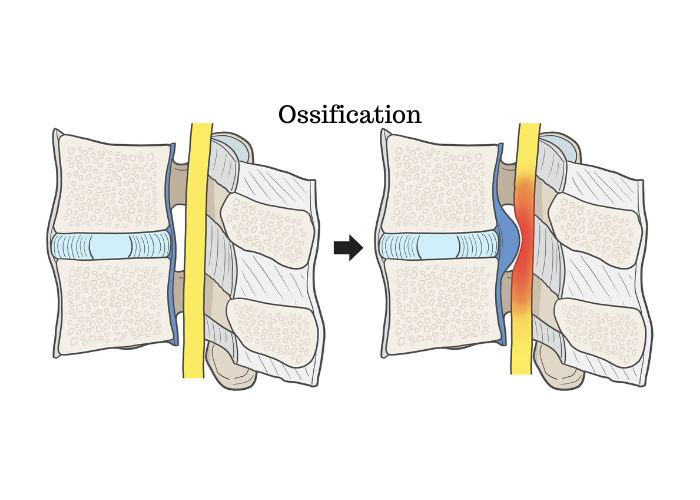Ossification of Posterior Longitudinal Ligament (OPLL) Specialist
Although rare, Ossification of Posterior Longitudinal Ligament is a serious, treatable condition that involves the thickening of a spinal ligament and thus a narrowing of the spinal canal. There is only so much room in the spinal canal. When a spinal ligament thickens, it compresses against the spinal cord, which can then radiate pain, weakness, or numbness to the rest of the body. Left untreated, it can lead to other conditions such as myelopathy, and result in an overall loss of mobility or disability. Doctor Andre M. Samuel, orthopedic spinal doctor, treats patients in Clear Lake, Houston, Sugar Land, TX area who have been diagnosed with OPLL. Contact Dr. Samuel’s team today!

What is Ossification of Posterior Longitudinal Ligament (OPLL)?
Ligaments are connective tissues that help to connect and hold bones in place, allowing for both stability and movement. Your back has five major ligaments, three of which are considered the most important ones. They are the ligamentum flavum, the anterior longitudinal ligament (ALL), and the posterior longitudinal ligament (PLL). The ALL and the PLL are about an inch wide and run the length (longitudinally) of the spine from the bottom of the cranium to the sacrum, with the ALL in the “front” (anterior) and the PLL in the “back” (posterior). Both the ALL and the PLL help to stabilize the bones of the spine, preventing the bones of the vertebrae from moving to excess.
Sometimes, the fibers of connective tissue can harden and calcify. This is called ossification, which means to turn into bone or become bone-like. When this occurs in the PLL, it is known as Ossification of the Posterior Longitudinal Ligament (OPLL). As the ligament thickens, it puts undue pressure on the spinal cord, leading to other physical and neurological problems. Doctor Andre M. Samuel, orthopedic spinal doctor, treats patients in Clear Lake, Houston, Sugar Land, TX area who have symptoms associated with ossification of the posterior longitudinal ligament in the neck or cervical spine.

What causes OPLL?
The causes of Ossification of Posterior Longitudinal Ligament are not completely known, though it is believed that genetics play a factor. It more commonly affects men than women and is more likely to affect men of Asian descent. It is most likely to onset after the age of 50.
Other risk factors appear to play a part such as age, environment, diabetes, lifestyle, hormones, and a diet rich in Vitamin A. Practicing good sleep habits in middle years has been shown to help prevent OPLL later on.
What are the symptoms of OPLL or Ossification of Posterior Longitudinal Ligament?
Patients in the early stages of OPLL may not at first notice any symptoms. However, as the condition progresses, they may experience:
- Tingling
- Numbness
- Neck Pain
- Pin and needle sensation
- Problems with balance
- Loss of fine motor control
- Loss of bowel or bladder function, caused by spinal cord compression
How is OPLL diagnosed?
Ossification of Posterior Longitudinal Ligament is diagnosed in a clinical visit with a specialist. In addition to reviewing your medical history and performing a complete physical, Dr. Samuel may order imaging such as an X-ray, CT scan, and an MRI. These tests can help Dr. Samuel determine any abnormalities that may be present, as well as help determine a best course of action for treatment.
What is the treatment for Ossification of Posterior Longitudinal Ligament (OPLL)?
Non-surgical treatment:
Ossification of Posterior Longitudinal Ligament can be treated conservatively with anti-inflammatory medications, muscle relaxants, cortisone injections, or steroids. These can also be used in conjunction with orthotics, physical therapy, or a lifestyle modification plan. While conservative measures may help alleviate symptoms of OPLL, surgery may be recommended to avoid permanent damage or injury to the spinal cord.
Surgical treatment:
If severe spinal cord compression from OPLL is identified, causing difficulty with walking or with hand function, surgery may be considered. Also, if the patient has difficulty walking, or if there is evidence of spinal cord compression. Dr. Samuel may perform one of the following procedures:
- Anterior cervical discectomy with fusion (ACDF)
- Posterior Cervical Decompression and Fusion (PCDF)
- Posterior Cervical Laminoplasty
- Anterior cervical corpectomy with fusion
- Anterior-Posterior Cervical Decompression and Fusion



